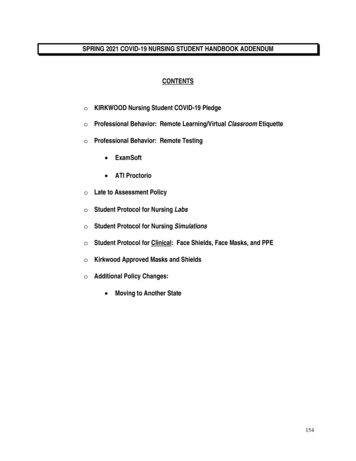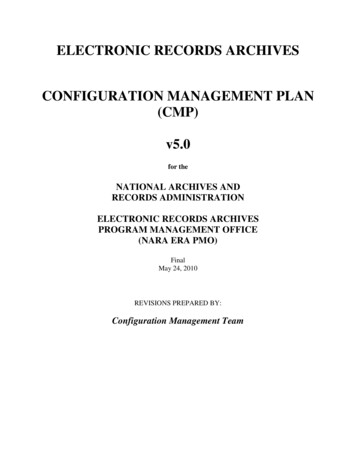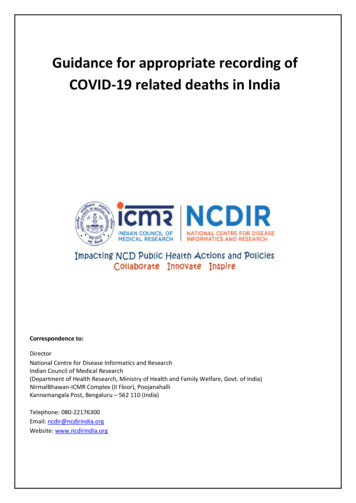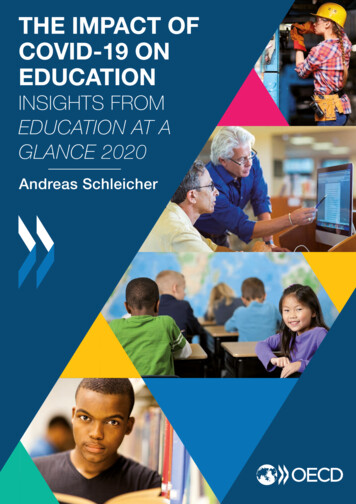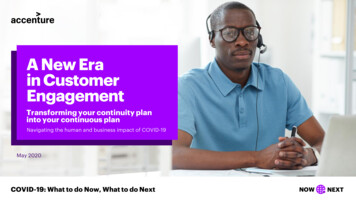
Transcription
A New Erain CustomerEngagementTransforming your continuity planinto your continuous planNavigating the human and business impact of COVID-19May 2020COVID-19: What to do Now, What to do NextNOWNEXT
We’re all in this togetherCOVID-19 has turned into a global crisis,evolving at unprecedented speed andscale in recent history. It is creating auniversal priority for governments andorganizations to take immediate action toprotect their people.It is now one of the biggest global events—and challenges—of our lifetimes. As such,it is changing human attitudes andbehaviors and forcing organizations torespond.However, the need to respond won’t endwhen the virus’s immediate threateventually recedes.2
“Whatever it is, [COVID-19] has made themighty kneel and brought the world to ahalt like nothing else could. Our minds arestill racing back and forth, longing for areturn to ‘normality’, trying to stitch ourfuture and our past offering us a chanceto rethink the doomsday machine we havebuilt for ourselves. Nothing could be worsethan a return to normality.Historically, pandemics have forcedhumans to break with the past and imaginetheir world anew. This one is no different.It is a portal, a gateway between oneworld and the next.”Arundhati Roy, Financial Times1Leading organizations see the opportunity andare already questioning the future of their salesand service organization, customers andworkforce. Company leaders want to know: What will the post-crisis business landscape look like? How do I create adaptability and resilience in my business? Where should I be focused to come out of the crisis stronger? Which customer expectations and behaviors are here to stay? Which temporary solutions should I be retaining longer-term? What rapidly deployed customer channel experienceswere well-received? Did shifts of my front-line employees impact my customers? What employee experiences should be retained or remedied? Are our workspaces optimized for the new normal? Which capabilities would have helped during the crisis? What do I need to do to create profitable growth in the new world?3
Adaptive Customer EngagementIt’s happening nowCOVID-19 is creating massive shifts in human behaviorand catalyzing end-to-end business reorientation.We believe impacts to customer engagement might besignificant and permanent.In this perspective, we explore how COVID-19has accelerated organizations to a new customerengagement standard. Predictable patterns haveproven unpredictable. Tried and true models havebeen upended. The old rule book is gone.The opportunity to transform is NOW. We see threepriorities businesses should address to activate andsupport purposeful experiences.01EMBRACE THE UNPREDICTABLEAccelerated shifts in customer interactions haveupended the “rules of engagement.”YOUR CUSTOMER02 FLEXWORKFORCEFlexible engagement models can deliver theseamless experience customers demand.RESILIENT03 EMPOWEROPERATIONS“Future-proof” operations to improve customerengagement for years to come.4
EMBRACING THE UNPREDICTABLENew and acceleratedcustomer interactionshave upended the “rulesof engagement.”5
(Digital) Engagementis everythingDigital channel usage is spiking throughout the pandemic.Corporate investment in digital experiences will need to mirrornew ways of living and working.How long such customer behavior will continue is unclear,but we do know there will be no return to the old ways ofoperating. Customer expectations for what constitutes “basic”digital capabilities have shifted permanently.As customers continue to “go” and “stay” digital, post-crisisexpectations for digital experience will continue to rise.Convenience, ease and accuracy will be table stakes.Intelligence, empathy and reciprocity will become thedifferentiators. Trust will be more critical than ever.Organizations need to prepare for the future of digitalengagement versus digital transactions. The speed at whichcompanies build and deploy these capabilities will become asource of competitive advantage and the degree to whichthey can sustain them will become a source of cost advantage.6“ We’ve witnessed stunningshifts in customerinteraction volume, typesand transactions. Thetimeline for developingrelationships withcustomers is nowsignificantly compressed.As customers navigatethese uncertain times,demonstrating empathythrough digital channelshas become the newstandard of engagement.”Dawn AndersonSenior Managing Director, Global Lead,Customer, Sales & Service, Accenture
Digital is now the defaultAt home, online and ready to engage. During their prolonged time at home,consumers have become more willing and able to use digital methods ofengagement. Already digital-savvy consumers are increasing their use,while individuals who once resisted digital interactions such as e-commerce,mobile finance and video calls are emerging as digitally engaged customers.Such changes are evident in industries ranging from beauty to groceries:The emergence of new digital customer profiles is likely to continue andwill require ongoing analysis to maintain the right customer sales and servicechannel mix. New customer preferences will also have significant implicationson the percent of total revenue businesses should expect to drivethrough e-commerce.Virtual access to everything. Our digital lives are our “real” lives. We areentering the Virtual Century. Social isolation has brought technology evencloser to the heart of the human experience. Take Facebook Live, for example.The service once faced limited adoption, but has experienced a resurgence,with 50 percent more people watching live videos monthly in the U.S.2 Sowhat did they watch? Mass held by Pope Francis, virtual tours of theCincinnati Zoo, and countless weddings by couples socially distanced fromtheir friends.3 The most impactful events have combined physical and digitaldimensions to create global reach for previously localized experiences.Arguably more surprising than the abundance of virtual social engagementsare the shifts for advisory services once thought to require in-personinteractions. Medical visits have found their way online, online learning andeducation is spiking and customers are getting more comfortable with remoteadvisory services, such as in banking and insurance. Digital is gaining tractionand trust as it is used during the crisis across critical business contexts,creating access, safety and continuity.7In a global consumer pulse survey4 71%report spending more timeonline during the crisisNew users expect to increasethe proportion of thepurchases made online by10%45%32%are completing onlineeducation during the crisisof purchases arebeing made online76%37%expect this behaviour tocontinue post-crisisOnline purchasesexpected post-crisis1 in 544%who ordered their lastgrocery purchase onlinedid so for the first timeFor those aged 56 , this was1 in 3are accessing healthcareonline during crisis77%expect this behaviourto continue post-crisis
The shift from transactionsto relationship-basedinteractionsReinforcing value through (and after) the crisis. Trust haslong been a critical component of digital customerengagement, but COVID-19 has brought the true purpose ofbrands to the fore. It has also put the notion of safety front andcenter in customer values. Post-crisis, customers will bereflecting back to think about how brands performed underpressure. During the pandemic, did customer sales and serviceorganizations deliver on their brand promise? Did they putsafety of their customers and their workforce ahead of theirfinancial priorities? How did they demonstrate they deservecustomer trust?Both during and post-crisis, companies should focus customerengagement on reassurance and confidence-building tocontinuously reinforce the value of products, services and theorganization itself. For example, a luxury automobile companymay not be inherently well placed for success during globalisolation measures. However, one brand recently created avirtual showroom that promotes personal safety and ease ofvehicle use without mention of COVID-19. The innovationdemonstrates that digital capabilities created during thepandemic can become a permanent engagement strategy.8“ Exceptional customerengagement meanschanging how weunderstand and respondto customer behavior,needs, and attitudes.Forward-thinkingengagement modelswill make digitalexperiences morehuman at a global scale.”Matteo MagaManaging Director, Growth Markets Lead,Customer, Sales & Service, Accenture
FLEXING YOUR CUSTOMER WORKFORCEFlexible engagementmodels can deliver theseamless experiencescustomers demand.9
Unstoppable adaptationMany companies have been forced to create agility in theirworkforce to support the changing needs of their businessduring the crisis. The lines between different human customersupport channels have blurred, with retail storerepresentatives, field service technicians and even airline gateagents temporarily shifting their focus to the call center, usingchat and voice platforms to continue servicing customers.Traditional barriers have disintegrated. Customer operatingmodel lines have been distorted. In the face of change, salesand service organizations held their breaths and threw out therule book in the name of creating continuity for theircustomers. And in most cases, it worked. Better than expected.As a result, the foundation has been set for organizations tothink more holistically about the flexibility of their workforceacross customer engagement touchpoints. This will drivesignificant changes in customer sales and support operatingmodels as well as the workforce skills required to succeed.10“ Operating model changes willbenefit both companies andtheir workforce. They’ll findopportunities for moreflexible and fulfillingemployment andunprecedented workforceresults. Companies canachieve such results throughrestructuring operationssupport models,standardizing platformsacross their organizationsand investing in analyticsto guide decision-making.”Bruce M. Holley,Senior Managing Director,North America Lead,Customer, Sales & Service
Home is where the work isChange in work-from-homefrequency from pre- to post-outbreak5Virtual workplaces, real results. Most organizations needed to do theunthinkable during the COVID-19 crisis: Make an entire workforceoperate from their homes. Banks, communication providers andgovernments shifted thousands of agents to remote work, overcominginfrastructure, security and speed-to-competency barriers along the way.As an example, a US communications provider successfully moved morethan 10,000 agents to work-from-home environments in a period of 3weeks.Since work-from-home models have been effective in creating safetyfor the workforce without compromising customer quality, we expectcompanies to shift work locations from physical to virtual, retaininglarger percentages (if not 100%) of work-from-home positions. Thiswill give them more flexibility to respond to customer needs with anoptimized cost structure – consolidating roles and physical spaces innew ways. New standards, certifications and “starter kits” will beredefined to create consistency of at-home-workplace standards atscale.Teams may consist of individuals with skills to address customer needsacross the customer lifecycle or to take full issue ownership at certainlifecycle stages. This will help simplify customer engagement as well asworkforce operations. The disruption of the agent “journey” will meanthat the management approach will shift from line management torelationship management as cross-functional teams operate acrossmultiple locations.11Less13%Same57%More30%Further, 46 percent of people whonever worked from home previouslynow plan to work from home moreoften in the future.
More flexible than everBlurring boundaries betweenfront office and back officeRapid digital channel adoption is creating newdynamics for the human workforce. Customerengagement will rely heavily on digital, social andvirtual assistant technology. With the growth ofthese channels, the human workforce’s role mustexpand. Traditional boundaries between the frontoffice and the back office will cease to exist. Salesand service agents must now support customersand become back office “knowledge engineers” – anew area of focus tasked with providing inputs tomaximize the quality and effectiveness of digitalexperiences, such as training AI solutions.12The crisis is also putting a spotlight on traditional agent-sourcingstrategies and business continuity plans. We now expect manyorganizations to revisit their sourcing mix, looking at opportunitiesto expand partnerships with third-party agent providers to shareoperational risk, create capacity for volume fluctuations andincrease resiliency.With these shifts, evolving operational support capabilities will becrucial. Operations functions will need to support a broader scopeof work and take advantage of data to inform insights and actions.Workforce demand planning must be extended across thecustomer support needs, across customer lifecycles and acrossnew customer contact shift patterns, which will require enhancedanalytics. Sourcing criteria must also evolve significantly.Selection criteria must prioritize business resilience and workfrom-home capability maturity in addition to cost and vendorpartners who will have to prove they can effectively hire, recruit,manage and retain new types of talent. Success will require moreongoing collaboration and partnership, redefining partnershipcontracting models and incentive structures.
More dynamic than everFluid talent models forexceptional serviceVirtual work environments and blended workforceexpectations represent a shift from traditionalcustomer engagement strategies. The workforcewill require new competencies and greater agilityto serve customers. There will be a heightenedexpectation that workers can seamlessly moveacross channels, from retail to the field to the callcenter to the back office.13To meet these needs, workforce profiles will need to be reimaginedwhile analytics are leveraged to optimize hiring. Successmeasurement for these roles will also need to be redefined:Businesses will need to focus on the metrics that matter. The focusof performance metrics must move away from transactionalmeasurement to evaluating success in creating value throughcustomer interactions. More than ever, an agent must truly owncustomer interactions end-to-end. Imagine retail sales repsevaluated on creating an enduring relationship versus immediateconversions, encouraged to share their “digital business card” tosupport a customer throughout their buying and onboardingjourney. New analytics correlations will be necessary to establishhigh-performer profiles and redefine performance outliers.Finally, empowering people to meet heightened flexibilityexpectations will be critical. Technology solutions must be advancedto help free agents to focus more on developing relationships anddelivering outcomes to their customers. Organizations must simplifytraditionally complex agent desktop, point-of-sale and field solutionsand build scale by integrating AI into their operations. Less focus onthe process enables greater focus on the customer, positioningagents for success.
EMPOWERING RESILIENT OPERATIONS“Future-proof”operations forimprovingcustomerengagement foryears to come.14
It’s time: transform to thriveAre organizations prepared for the scale of the new digital consumer?While COVID-19 has accelerated innovation in many ways, it has alsoexposed the fragility of our economy and the insufficiency oftraditional continuity plans. Digital and human resilience is critical.Governments and enterprises that have made investments to createan agile human and digital workforce have laid the groundwork tonavigate the crisis and fare better than their counterparts.Customer organizations that shifted to cloud technology, advanceddata solutions and mobile employee technology pre-crisis were ableto navigate the impact of the pandemic quickly and more confidently.In the face of sustained customer behavior acceleration, there will begreater demand for flexibility of physical spaces, platforms and data.To succeed, companies should continuously recalibrate requirementsand investments against outcomes. Space investments must bere-justified. Platform investments must yield results faster. Data mustbe comprehensive and accessible to power dynamic decisions. Thosewho have not planned for an unpredictable future must get therequickly.15
Redefining workspacesA new kind of spatial awareness. With workforces relocated, physical retailersclosed and offices sitting vacant, businesses are being forced to rethink theirdefinition of and investments in customer-centric workspaces. Hygiene inphysical spaces – once assumed – has been elevated to become a new driver ofexperience. As the crisis evolves and businesses prepare to reopen, physicalspace investments (retail and corporate) are being reevaluated.In the call center environment, a prolonged period where the majority of agentsworked virtually has set the stage for a net new approach to physical call centers.Companies are already starting to look for cost synergies by reconsidering theirphysical call center space investments and configurations.In store and branch environments, extended closures of physical spaces areputting pressure on companies to reevaluate retail for value and viability. Trendsexpected to come to fruition by 2025 are being accelerated as brands redefinethe role of physical space in the overall customer engagement strategy.Economic conditions, the rise of digital engagement and pressure on health andsafety will create the impetus to reconfigure the retail footprint, redefine retailpurpose and reinvent retail experiences.16What we predicted stores and branches wouldlook like in 2025630%Fewer traditionalstores/branches20%New experiencestores/branches70%Fewer tellers/transactionalemployee roles50%Employees in newrelationship roles30%Lessfloor space
Resilience at scaleIntensifying platforms pressures. Resilient technologies must underpin more nimblebusiness. Platform adopters that have invested in “future-proofing” their technologylandscape are best prepared for disruption. New product usage and monetizationdemands, increased emphasis on previously underserved aspects of the customerlifecycle, and dramatic shifts in digital channel engagement will require unprecedentedagility in the enabling platforms to meet and exceed customers’ needs. For example,companies serving small businesses must be prepared for an influx of customersbeginning their “back to business” journey – separate and distinct from commonacquisition, retention, and service experiences.Companies that demonstrate that they know their customers and have leveraged platformcapabilities to address their needs in this time of uncertainty will be rewarded. Companieswho have effectively decoupled their digital platforms from back office systems andprocesses will be well prepared to launch new experiences, apps, and even new marketpropositions and products with agility.A dynamic approach to data. The COVID crisis has shown that internal data is no longersufficient to inform and predict customer and employee needs. A combination of internaland external data will be required in the future to fully inform business decisions.Customer preferences in contact channels must inform new staffing models, identifyingopportunities to integrate AI tools to handle low-complexity intents. Shifting sales channelpreferences will require a data-driven approach to product supply and allocation andservice to maximize revenue and customer satisfaction. Investing in advanced, real-timeanalytics models to inform customer sales and service decision-making will be critical tomaintain adaptability and competitiveness in the new environment.17“ COVID-19 has hit thefast-forward button forus. Customers aredemonstrating behaviorswe didn’t expect tosee until 2025. Now,businesses must catch up.Using digital to createbusiness continuity is nolonger a nice-to-have. It’sthe new normal.”Edwin VanderOuderaa,Senior Managing Director,Europe Lead, Customer, Sales & Service,Accenture
We’ll leaveyou with thismessageToday’s trying times are setting the stage forunprecedented opportunities.Amid uncertainty, there is innovation.Amid disruption, there is reinvention.And through it all, we are here to help.18
How Accenture can help build your future NOWAssess and PlanAccelerate to AdaptRotate and ReinventWhere are you today?How quickly can you getto tomorrow?Design your NOW strategy.Create the future at scale.Run, reflect and refine.We can work with you on a rapiddiagnostic covering: Customer touchpoint mix Workforce flexibility Space readiness Platforms Data and analytics Overall function support modeland associated spend19Prioritize, mobilize, get going. Create an accelerated end-to-endexperience and touchpoint strategy Conduct design sprints to reimaginethe role physical spaces play in theorganization ”Zero-base” your customer functionsupport model and financials Optimize and prioritize yourexecution roadmap investments Kick off agile execution of toppriority initiatives Continuously recalibratestrategy effectiveness through testand-learn Continue to execute prioritizedroadmap focused on holisticexperience transformationspanning people, technology,operations and physical spaces Measure success and outcomes:business value, customer value andemployee value Continue to reflect, using analyticsto adaptively refine strategy andexecution to improve flexibility andoutpace change
References1. Arundhati Roy (2020) ‘The pandemic is a portal’ Financial Times, 3rd April [Page 3]2. SocialMediaToday. Facebook Adds New Tools for Facebook Live Amid Rising Demand and Usage [Page 7]3. Forbes. What To Know About The Vatican’s Unprecedented Virtual Easter Week This Year [Page 7]3. CNN. 20 amazing virtual field trips to aquariums, museums and Mars [Page 7]4. Accenture Covid-19 Consumer Survey. Accenture Research conducted the research to understand how global consumer priorities,purchasing decisions, and behavioral patterns are shifting in the wake of coronavirus. The survey was conducted between 19 th – 25thMarch 2020, and comprised of 3,313 consumers and between 2nd - 6th April 2020, and comprised of 3,074 consumers. Both surveyswere conducted in 15 countries at differing stages of the outbreak: Australia, Brazil, Canada, China, France, Germany, India, Italy,Japan, Mexico, South Korea, Spain, United Arab Emirates, UK, and USA. [Page 7]5. Accenture Experience [Page 1]6. Accenture COVID-19 Consumer Pulse. conducted 2nd–6th, April 2020, N 1,118 respondents working from home [Page 12]7. Allen International. Retail design & customer experience from Accenture. [Page 15]20
ContactsDawn AndersonEdwin VanderOuderaaMatteo MagaBruce M. HolleySenior Managing DirectorGlobal LeadCustomer, Sales & ServiceSenior Managing DirectorEurope LeadCustomer, Sales & ServiceManaging DirectorGrowth Markets LeadCustomer, Sales & ServiceSenior Managing DirectorNorth America LeadCustomer, Sales & ServiceErika SimpsonMichelle McGlynnAndrew GalanopoulosLan GuanManaging DirectorGlobal Technology LeadCustomer, Sales & ServiceManaging Director,Accenture AppliedIntelligenceManaging DirectorNorth America Strategy LeadCustomer, Sales & Service21Managing DirectorGlobal Innovation LeadCustomer, Sales & Service
To help our clients navigate both thehuman and business impact of COVID-19,we’ve created a hub of all of our latestthinking on a variety of topics.Each topic highlights specific actions whichcan be taken now, and what to consider nextas industries move towards a new normal.From leadership essentials to ensuringproductivity for your employees andcustomer service groups to building supplychain resilience and much more, our hubwill be constantly updated. Checkback regularly for more insights.VISIT OUR HUB HERE22
About AccentureAccenture is a leading global professional services company, providinga broad range of services and solutions in strategy, consulting, digital,technology and operations. Combining unmatched experience andspecialized skills across more than 40 industries and all businessfunctions—underpinned by the world’s largest delivery network—Accenture works at the intersection of business and technology to helpclients improve their performance and create sustainable value for theirstakeholders. With 509,000 people serving clients in more than 120countries, Accenture drives innovation to improve the way the worldworks and lives.Visit us at www.accenture.comDISCLAIMER: This document is intended for general informational purposes only and does not take intoaccount the reader’s specific circumstances, and may not reflect the most current developments.Accenture disclaims, to the fullest extent permitted by applicable law, any and all liability for the accuracyand completeness of the information in this presentation and for any acts or omissions made based on suchinformation. Accenture does not provide legal, regulatory, audit, or tax advice. Readers are responsible forobtaining such advice from their own legal counsel or other licensed professionals. This document makesdescriptive reference to trademarks that may be owned by others. The use of such trademarks herein is notan assertion of ownership of such trademarks by Accenture and is not intended to represent or imply theexistence of an association between Accenture and the lawful owners of such trademarksCopyright 2020 Accenture All rights reserved.Accenture, its logo, and New Applied Now are trademarks of Accenture.
Customer, Sales & Service, Accenture 8 Reinforcing value through (and after) the crisis. Trust has long been a critical component of digital customer engagement, but COVID-19 has brought the true purpose of brands to the fore. It has also put the notion of safety front and center in


